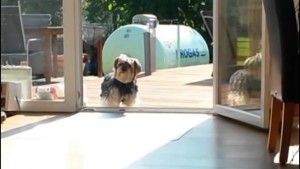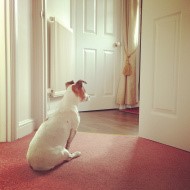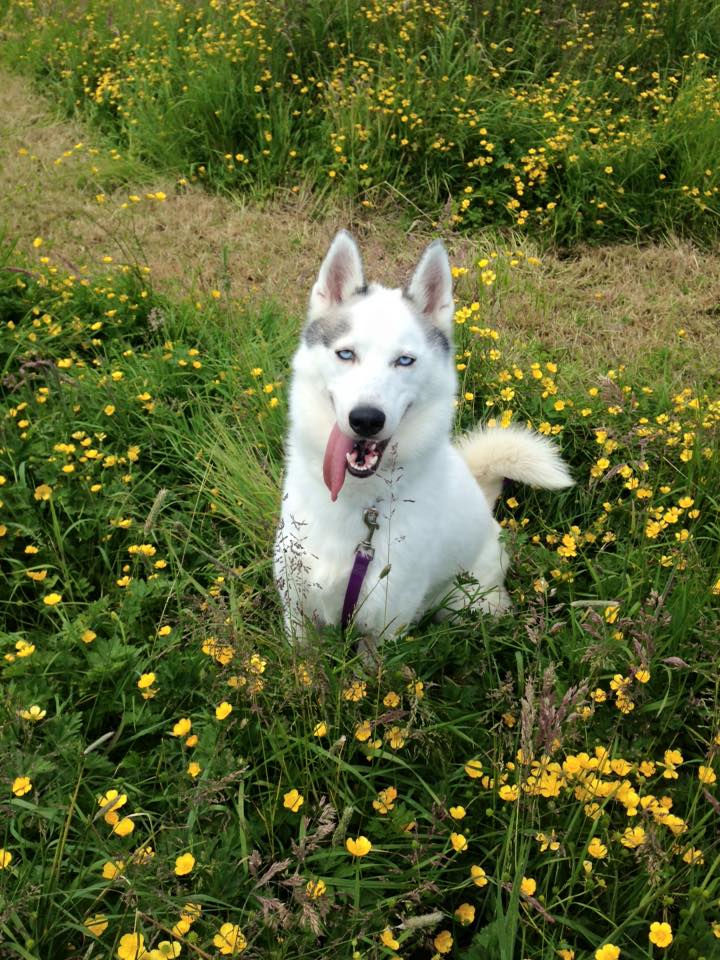It might seem like a strange concept but for those living with a dog that is afraid to go through a doorway in the home it can be a real issue. If you have a dog that is occasionally or permanently stuck behind an invisible barrier unable to cross a threshold this blog is for you.

Imagine wanting to be with your family but being unable to do so.
For some dogs moving across a threshold or through a doorway can be a scary thing. Their family can become frustrated and confused about the apparent invisible door that leaves their dog unwilling or unable to venture beyond. What we need to do is understand why our dogs are stuck and help them to feel better about making the choice to move through a doorway when asked.
Possible reasons for your dog’s reluctance to move through a doorway
- What is on the other side is scary; front door out onto an unpredictable road, floor surface changes, busy room where the dog previously got a fright etc.
- Moving through the doorway itself is scary; flapping curtains, swinging door, raised door sill etc.
- Dog’s sensory perception is effected or has physical discomfort; poor eyesight, hearing impairment, arthritic joints etc.
- If it is a glass door has the dog ever knocked into it (as a child who ran into a closed sliding patio door I know how easily done it is!
 )
) - Your dog has learned that moving through the doorway has a negative consequence e.g. you put them outside when they are going to be left and they suffer from separation anxiety.
- Other animals in the home preventing them physically or behaviourally moving through the door.
- Previous experience of being punished around trying to come through a door; shouted at, blocked, physically reprimanded etc.
The dog is afraid of what is on the other side 
- Uneven, echo creating or slipper floor surface – put down a rug.
- Lots of people or vehicle traffic outside the front door – bring out at quiet times.
- If there is something scary about the room they are entering – e.g. washing machine makes a loud noise on the spin cycle – make sure the machine is not on when they are coming in.
Moving through the doorway itself is scary
- Secure anything that could move or fall over if for example a breeze blew outside or someone opened another door creating a draft.
- Look at propping the door open to ensure if the dog goes to move forward they don’t suddenly find the door swinging shut on them.
- Try and make the path up to the door and immediately on the other side clear of all clutter so the dog can see if they move in that they are not going to be trapped.
- If possible prop open another door so the dog can see an escape route if they do make the decision to go through the doorway.
Dog’s sensory perception is effected or has physical discomfort
It is important that you rule out any underlying medical cause for behaviour so if you feel that your dog may have a undiagnosed issue or is in pain please take them to the vet.

Special “feeler” collar – with optional added angel wings :-)
Visual impairment
- Place a textured mat on either side of the door to signal to the dog that they are about to step through a doorway.
- Scent the doorframe with essential oils so the dog can work out a mental picture of where the door opening is.
- Place a chime on the door frame so the dog can hear when the door is opening or closing.
- Fasten doors open with a latch so they are never bumping into closed doors.
- Stick a textured square on the door at nose level for your dog so they can feel if it is closed – might also be worthwhile scenting this with a specific scent.
- Look at making or purchasing a special collar that has “feelers” on it that extend beyond your dogs head so their nose is not the first thing that makes contact with a door.
Hearing impairment
- Try and make sure the dogs resting places are positioned in such a way that they can see the door opening and closing so they don’t get a fright.
- Make sure all people movement through door ways is as predictable as possible i.e. don’t rush through the door brushing past them when they are eating etc. Take your time and let them see you going through the door.
- Fasten doors open with a latch so they are never startled by closing or opening doors.
Physical discomfort

A steady low level ramp may be easier then steps for your dog to navigate.
Try to identify why your dog may be finding it difficult to move through the door.
- Do they have to go up steps – could you use a dog ramp?
- Is the ground uneven – place a blanket on the ground?
- High door sill that the dog is tripping on – change the sill or in the mean time place a rug over it to make it more even?
As mentioned above if you think your dog is in any pain please consult with your veterinarian about pain relief medication.
Cannot work out a glass patio door
Some dogs are afraid of glass doors as they can cause reflections and also can be difficult to figure out if they are open or closed.
There are lots of videos on YouTube of dogs refusing to walk through invisible doors until their owners pretend to open them. This is probably due to the dog at some point having a negative experience with believing the door was open and running into it.

Stuck behind an invisible glass door
If you think this might be the case for your dog look at putting a laminated sheet at eye level so they can clearly see when the door is open or closed.
This will also help with blocking any reflections that the dog may be worried by.
If you don’t want to put laminate on your door as this is too much of a permanent feature you could perhaps look at selotaping some pretty paper up for the time being and eventually reduce this down to a simple sticker at the dogs eye level.
Your dog has learned that moving through the doorway has a negative consequence

Chilling out in their bed while you pop to the shop may be much nicer then waiting in the garden.
Change the consequence for the dog.
- Example – you are heading out for an hour & the dog is always ask to go out to the garden – perhaps they could spend the time you are out in the house instead with a nice chew and toys to play with.
- Example – heading out the front door always means getting in the car which they don’t enjoy bring them out on lead & play games or do some fun training exercises instead.
Other animals in the home preventing them, physically or behaviourally, moving through the doorway.
Priority access to resources is the main reason why there is tension between dogs in a multi-dog household. A resource is anything the dogs considers important – food, water, sleeping spaces, toys, fuss from their people or even the best position for begging at the kitchen table. If one dog is consistently being bullied out of the way by another dog in the home you may need to look at managing their interactions a little better and controlling the environment so you are setting both dogs up for success for example teaching each of them a wait or bed cue.

A doorway into a sleeping area, food bowl or company can be a valuable space that a dog may guard.
If one dog is blocking the other dog from entering the house – look around and see why this might be happening e.g. the food bowls are immediately inside the back door etc. Look at moving their food bowls and perhaps go one step further and perhaps feed the dogs in separate areas.
Previous experience of being punished around trying to come through a door – shouted at, blocked or physically reprimanded, or never experienced being indoors as a puppy during the critical behaviour development period (first 16 weeks of their life).
- For these dogs it is tricky as they have an established negative association with doorways that can be hard to change. Punishment by its very definition stops or reduces a behaviour so changing past learning that centred around punishment can be slow and often very tedious.
- Equally dogs that have missed out on essential early socialisation and habituation can find novel situations extremely scary. However, if you ensure that your fearful dog is never forced to move through a doorway and follow the steps outlined below you will be able to change their emotional response and help them to feel better.
So how do we help change the behaviour through training?

Only move at a pace your dog is comfortable with.
Remove all pressure on the dog by leaving the door open and remaining with them on the side they are most comfortable.
Watch for subtle indicators that your dog may be unsure or anxious – ears back, slight backward positioning of their body, tense mouth or wrinkled forehead, stiffness or stillness, flashing whites of their eyes, licking their lips or panting and turning their head away. If you spot any of these signals this is your opportunity to allow you dog more space and therefore reassuring them that they are not going to be forced or coerced into a situation they are frightened by.
If they show any interest in moving towards the door or even look at it give them lots of reassurance and praise. Don’t be tempted to lure them into the space you wish them to be in as you will likely taint the food or toy and create more anxiety and suspicion.
Equally the dog is unlikely to fall for the same trick repeatedly so this method will only work a couple of times.
Avoid taking the dog by the collar and physically moving them through the door as this is leaving yourself wide open to your dog potentially biting you as you have left them with no other option to defend themselves from the very thing they are trying to avoid.
- Stand on the same side of the door as your dog at a distance that they appear comfortable – for some dogs this could be 6 feet away whereas for others it could be immediately at the door.
- Toss a low value piece of food or toy away from the door for your dog to retrieve. If the door you are trying to encourage them to move through it out into an unsecure outdoor area it would be worthwhile popping a harness and long line onto them for safety.
- Do this several times until the dog is happily moving away from the door and returning to you each time.
- Toss a high value food treat toward the door but not through it. If the dog goes to retrieve it – lots of verbal praise and fuss.
- Immediately follow by tossing a low value treat or toy away from the door – this allows the dog to see that we don’t keep raising the criteria making it harder and instead give them an opportunity to choose – low value easy or high value slightly trickier.
- Once they are moving towards the door confidently you can start to toss the high value food or toy just immediately inside the door for them to retrieve.
- At this point assess your dog – are they approaching full or starting to lose a bit of enthusiasm for the exercise – if so call it a day and give them a chance to rest and absorb the training. If they are happy to keep going great but just bear in mind that 10-15 minutes will be long enough for this particular training exercise.
- Repeat this exercise until your dog is moving through the door easily. You are now ready to start changing your position – repeat the exercise with you standing inside.
- If your dog is happily moving through the door with you on either side you can now begin to look at moving the door – remember it is all about your dog making choices and feeling like they have control over their environment. If they appear anxious about you closing the door simply work on moving it a few inches over before immediately opening it again.
It is important to note that like us, all dogs are unique individuals, and although the training for some dogs may take a matter of hours to successfully change how they feel for other dogs it may take weeks. Therefore it is important that you don’t rush it or become frustrated as they will get there and any attempt to force the progression will only put you both back at square one.

Charlie posing in the doorway!
Any questions please pop them in the comments section below.
Happy training everyone! 


I wanted to develop a brief word in order to appreciate you for all of the nice secrets you are giving out at this site. My particularly long internet lookup has now been paid with useful content to exchange with my family members. I ‘d express that we visitors are very much blessed to exist in a wonderful place with many outstanding individuals with beneficial ideas. I feel truly happy to have come across your web page and look forward to tons of more excellent moments reading here. Thanks again for a lot of things.
Thanks Odelia